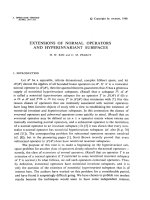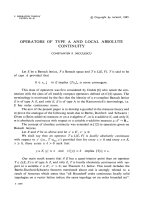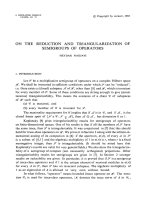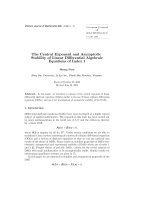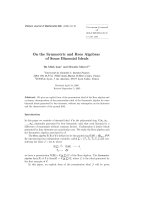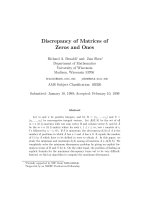Báo cáo toán học: " Enumeration of Varlet and Comer hypergroups" pptx
Bạn đang xem bản rút gọn của tài liệu. Xem và tải ngay bản đầy đủ của tài liệu tại đây (117.37 KB, 9 trang )
Enumeration of Varlet and Comer hypergroups
H. Aghabozorgi
Department of Mathematics
Yazd University, Yazd, Iran
h
M. Jafarpour
Department of Mathematics
Vali-e-Asr University of Rafsanjan, Rafsanjan, Iran
B. Davvaz
Department of Mathematics
Yazd University, Yazd, Iran
Submitted: Feb 12, 2011; Accepted: May 29, 2011; Published: Jun 14, 2011
Mathematics S ubject Classifications: 20N20, 05E15.
Abstract
In th is paper , we study hypergroups determined by lattices introduced by Varlet
and Comer, especially we enumerate Varlet and C omer hypergroups of orders less
than 50 and 13, respectively.
1 Basic definitions and results
An algebraic hyperstructure is a natural generalization of a classical algebraic structure.
More precisely, an algebraic hyperstructure is a non-empty set H endowed with one or
more hyperoperations that associate with two elements of H not an element, as in a
classical structure, but a subset of H. One of the interests of the researchers in the field
of hyperstructur es is to construct new hyperoperations using g raphs [18], binary relations
[2, 5, 7, 8, 9, 1 1, 15, 21, 23], n-ary relations [10], lattices [16], classical str uctures [13],
tolerance space [12] and so on. Connections between lattices and hypergroupoids have
been considered since at least three decades, starting with [24] and followed by [3, 14, 17].
This paper deals with hypergroups derived fr om lattices, in particular we study some
propert ies of the hypergroups defined by J.C. Varlet [24] and S. Comer [3] that called
here Varlet hypergroups and Comer hypergroups, respectively. Using the results of [1, 22]
the electronic journal of combinatorics 18 (2011), #P131 1
we enumerate the number of non isomorphic Varlet and Comer hypergroups of orders less
than 50 and 13, respectively.
Let us briefly recall some basic notions and results about hypergroups; for a compre-
hensive overview of this subject, the reader is referred to [4, 6, 25]. For a non-empty set
H, we denote by P
∗
(H) the set of all non-empty subsets of H. A non-empty set H, en-
dowed with a mapping, called h yperoperation, ◦ : H
2
−→ P
∗
(H) is named hypergroupoid.
A hyperg r oupoid which satisfies the following conditions: (1) (x ◦ y) ◦ z = x ◦ (y ◦ z), for
all x, y, z ∈ H (the associativity), (2) x ◦ H = H = H ◦ x, for all x ∈ H (the reproduc-
tion axiom) is called a hypergroup. In particular, an associative hypergroupoid is called
a semihypergroup and a hypergr oupoid that satisfies the reproduction axiom is ca lled a
quasihypergroup. If A and B are non-empty subsets of H, then A ◦ B =
a∈A,b∈B
a ◦ b.
Let (H, ◦) and (H
′
, ◦
′
) be two hypergroups. A function f : H −→ H
′
is called a homo-
morphism if it satisfies the co ndition: for any x, y ∈ H, f(x ◦ y) ⊆ f (x) ◦
′
f(y). f is a
good homomorphism if, for any x, y ∈ H, f(x ◦ y) = f(x) ◦
′
f(y). We say that the two
hypergroups are isomorp hic if there is a good homomorphism between them which is a lso
a bijection.
Join spaces were introduced by W. Prenowitz and then applied by him and J. Ja n-
tosciak both in Euclidian and in non Euclidian geometry [19, 20]. Using this notion,
several branches of non Euclidian geometry were rebuilt: descriptive geometry, projective
geometry and spherical geometry. Then, several important examples of join spaces have
been constructed in connection with binary relations, graphs and lattices. In order to de-
fine a join space, we need the following notation: If a, b are elements of a hypergroupoid
(H, ◦ ) , then we denote a/b = {x ∈ H | a ∈ x ◦ b}. Moreover, by A/B we intend the set
a∈A,b∈B
a/b.
A co mmutative hypergroup (H, ◦) is called a jo i n space if the following condition holds
for all elements a, b, c, d of H:
a/b ∩ c/d = ∅ =⇒ a ◦ d ∩ b ◦ c = ∅.
Definition 1.1. [24] Let L
≤
= (L, ∧, ∨) be a lattice with join ∨, meet ∧ and order relation
≤ and let:
∀(a, b) ∈ L
2
, a ◦ b = {x ∈ L | a ∧ b ≤ x ≤ a ∨ b} .
Theorem 1.2. [24] For a lattice L
≤
the following are equivalent:
(1) L
≤
is distributive;
(2) L
≤
= (L, ◦) is a join space.
The class of int ervals of elements of L
≤
= (L, ∧, ∨) is denoted by I(L
≤
), that is:
I(L
≤
) = {[a, b] | (a, b) ∈ L
2
, a ≤ b},
where [a, b] = {x ∈ L | a ≤ x ≤ b}.
the electronic journal of combinatorics 18 (2011), #P131 2
Theorem 1.3. For the join space L
≤
given in Theorem 1.2, the following equality holds:
Sub(L
≤
) = I(L
≤
) = {x ◦ y|(x, y ) ∈ L
2
},
where Sub(L
≤
) is the class of subhypergroups of L
≤
.
Proof. Let [a, b] ∈ I(L
≤
). Then, for any x, y ∈ [a, b] we have a ≤ x ≤ b and a ≤ y ≤ b.
These lead to a ≤ x ∧ y ≤ x ∨ y ≤ b and so x ◦ y = [x ∧ y, x ∨ y] ⊆ [a, b]. Moreover,
[a, b] ◦ x = x ◦ [a, b] =
t∈[a,b]
x ◦ t = [a, x] ∪ [x, b] = [a, b]. Conversely, let H ∈ Sub(L
≤
),
a ◦ b ⊆ H, f or all a, b ∈ H. Hence, [a ∧ b, a ∨ b] ⊆ H. In particular, one obtains that H
is closed under the operations ∧ and ∨. Let A = {a
i
}
i∈I
and B = {b
i
}
i∈J
are the sets
of minimal and maximal elements of H, respectively with respect to the order on L. If
|I| ≥ 2, then we can choose two distinct elements of A, say a, a
′
, it follows that a ∧ a
′
∈ H
a contradiction. In this way, A contains a unique element, say a
0
. Similarly, B co ntains
a unique element, say b
0
. It is clear that H = [a
0
, b
0
]. We can easily see that the equality
I(L
≤
) = {x ◦ y|(x, y ) ∈ L
2
} holds.
Theorem 1.4. Let L
≤
= (L, ∧, ∨) be a distributive lattice. De fine on the set I(L
≤
), the
following hyperoperation
[x, y] ⊙
R
[z, w] = Sub([x ∧ z, y ∨ w]).
Then, (I(L
≤
), ⊙
R
) is a hypergroup.
Proof. Using previous theorem, it is clear that ⊙
R
is a well defined hyperoperation. We
prove ⊙
R
is associative. To this end we have:
([x
1
, y
1
] ⊙
R
[x
2
, y
2
]) ⊙
R
[x
3
, y
3
] = Su b([x
1
∧ x
2
, y
1
∨ y
2
]) ⊙
R
[x
3
, y
3
]
= Su b([(x
1
∧ x
2
) ∧ x
3
, (y
1
∨ y
2
) ∨ y
3
])
= Su b([x
1
∧ (x
2
∧ x
3
), y
1
∨ (y
2
∨ y
3
)])
= [x
1
, y
1
] ⊙
R
Sub([x
2
∧ x
3
, y
2
∨ y
3
])
= [x
1
, y
1
] ⊙
R
([x
2
, y
2
] ⊙
R
[x
3
, y
3
]).
2 Enumeration of finite Varlet hypergroups
It is well known that every binary relation ρ on a finite set L, with cardL = n, may be
represented by a Boolean matrix M(ρ) and conversely every Boolean matrix of order n
defines on L a binary relation. Indeed, let L = {a
1
, , a
n
}; a Boolean matrix of order n
is constructed in the following way: the element in the position (i, j ) of the matrix is 1 , if
(a
i
, a
j
) ∈ ρ and it is 0 if (a
i
, a
j
) /∈ ρ and vice versa. Hence, on every set with n elements,
2
n
2
partial hypergroupoids can be defined. Recall that in a Boolean algebra the following
propert ies hold: 0 + 1 = 1 + 0 = 1 + 1 = 1, while 0 + 0 = 0, and 0 · 0 = 0 · 1 = 1 · 0 = 0,
1 · 1 = 1. Moreover, if ρ is a binary relation on L, then M(ρ
2
) = M
2
(ρ).
the electronic journal of combinatorics 18 (2011), #P131 3
Proposition 2.1. Let L
≤
and L
≤
′
be two finite lattices and (t
ij
), (t
′
ij
) be their associated
matrices, respectively. The n, L
≤
and L
≤
′
are isomorphi c if and only if t
ij
= t
′
σ(i)σ(j)
, f or
a permutation σ of the set {1, 2, . . . , n}.
Definition 2.2. Let L
≤
be a finite lattice. The matrix M(≤) is called very good if and
only if L
≤
is a Varlet hypergroup.
Proposition 2.3. If M = (t
ij
)
n×n
is a ve ry good matrix an d M
2
= (s
ij
), then the
following assertions hold:
(1) t
ii
= 1, for all 1 ≤ i ≤ n;
(2) t
ij
= 1 ⇒ t
ji
= 0, for all i = j and 1 ≤ i, j ≤ n;
(3) M
2
≤ M, (i.e., s
ij
= 1 ⇒ t
ij
= 1, for all 1 ≤ i, j ≤ n);
(4) there e xists i, with 1 ≤ i ≤ n, such that t
ij
= 1, for all 1 ≤ j ≤ n;
(5) there e xists j, with 1 ≤ j ≤ n, such that t
ij
= 1, for all 1 ≤ i ≤ n.
The matrix T = (t
ij
)
n×n
, with
t
ij
=
1 if i ≤ j
0 otherwise,
for any i, j ∈ {1, 2, . . ., n}, is a very good matrix that we call it n-triangular and the
corresponding hypergroup is a Varlet hypergroup.
In the following, we g ive in terms of matrices a necessary and sufficient condition
such that two Varlet hypergroups associated with two lattices on the same set L, are
isomorphic.
Proposition 2.4. Let L = {a
1
, . . . , a
n
} be a finite set, ≤ and ≤
′
be two order relations
on L and M(≤) = (t
ij
), M(≤
′
) = (t
′
ij
) be their associated matrices. If t
ij
= t
′
σ(i)σ(j)
, for
a permutation σ of the set {1, 2, . . . , n}, then the following assertions hold:
(1) a
i
≤ a
j
⇔ a
σ(i)
≤
′
a
σ(j)
;
(2) a
i
∧ a
j
= a
k
⇔ a
σ(i)
∧ a
σ(j)
= a
σ(k)
;
(3) a
i
∨ a
j
= a
k
⇔ a
σ(i)
∨ a
σ(j)
= a
σ(k)
.
Theorem 2.5. Let L
≤
and L
≤
be two finite distributive lattices and let M(≤) = (t
ij
) and
M(≤
′
) = (t
′
ij
) be their associated matrices. The hypergroups L
≤
and L
≤
′
are isomorphic
if and only if t
ij
= t
′
σ(i)σ(j)
, for a permutation σ of the se t {1, 2, . . ., n}.
the electronic journal of combinatorics 18 (2011), #P131 4
Proof. Let L = {a
1
, . . . , a
n
} and θ : L
≤
−→ L
≤
′
be an isomorphism. Then, θ(a
i
◦ a
j
) =
θ(a
i
) ◦
′
θ(a
j
) and so
{θ(a
k
) | a
i
∧ a
j
≤ a
k
≤ a
i
∨ a
j
} = {a
s
|θ(a
i
) ∧ θ(a
j
) ≤
′
a
s
≤
′
θ(a
i
) ∨ θ(a
j
)}.
Thus, we have a
i
∧ a
j
≤ a
k
≤ a
i
∨ a
j
if and only if θ(a
i
) ∧ θ(a
j
) ≤
′
θ(a
k
) ≤
′
θ(a
i
) ∨ θ(a
j
).
Suppose that θ(a
j
) = a
σ(j)
, for a permutation σ of the set {1, 2, . . . , n}. We show that
t
ij
= t
′
σ(i)σ(j)
. If t
ij
= 0, then we can easily see that t
′
σ(i)σ(j)
= 0. Now, supp ose that
t
ij
= 1. Then, we have t
′
σ(i)σ(j)
= 1 or t
′
σ(j)σ(i)
= 1. Since t
ji
= 0 the case t
′
σ(j)σ(i)
= 1
would not occur. Thus, we have t
′
σ(i)σ(j)
= 1. Conversely, note that, for a permutation σ
of the set {1, 2, . . . , n}, we have a
i
≤ a
j
⇔ a
σ(i)
≤
′
a
σ(j)
. Consider the map ϕ : L
≤
→ L
≤
′
with ϕ(a
i
) = a
σ(i)
. Clearly, ϕ is a bijection and by using previous proposition we have:
{ϕ(a
k
) | a
i
∧ a
j
≤ a
k
≤ a
i
∨ a
j
} = {a
σ(k)
| a
σ(i)
∧ a
σ(j)
) ≤
′
a
σ(k)
≤
′
a
σ(i)
∨ a
σ(j)
}.
Therefore, ϕ(a
i
◦ a
j
) = ϕ(a
i
) ◦
′
ϕ(a
j
) and the proof is completed.
We say that a Boolean mat rix is reflexive, antisymmetric or transitive if the associated
binary relation is reflexive, a ntisymmetric or transitive, respectively.
We say that two very good matrices are isomorphic if the Va r let hypergroups obtained
by them are isomorphic.
Theorem 2.6. Let M = (t
ij
)
n×n
and M
′
= (t
′
ij
)
m×m
be two very good matrices. Then,
M ⊕ M
′
= (m
ij
)
k×k
, where k = n + m, an d
m
ij
=
t
ij
if i ≤ n, j ≤ n
t
′
ij
if n < i, n < j
1 if i ≤ n, j > n
0 if n < i, j ≤ n
is a very good matrix.
Proof. Since M ⊕ M
′
=
M O
′
O M
′
k×k
, where O is an m × n matrix which all entries
are zero (i.e., O = (0)
m×n
), and O
′
is an n × m matrix which all entries are one. We have
(M ⊕ M
′
)
2
= M
2
⊕ M
′2
≤ M ⊕ M
′
and so M ⊕ M
′
is a transitive matrix. Obviously,
M ⊕ M
′
is reflexive and antisymmetric. Now, suppose that L = {a
1
, . . . , a
n+m
} and ≤ is
the associated binary relation of M ⊕ M
′
. Then
a
i
≤ a
j
⇔ [t
ij
= 1 or t
′
ij
= 1, and (i ≤ n, j > n)].
Hence, a
i
∧ (a
j
∨ a
k
) ≤ (a
i
∧ a
j
) ∨ (a
i
∧ a
k
), for every (a
i
, a
j
, a
k
) ∈ L
3
. So, (L, ≤) is a
distributive lattice a nd M ⊕ M
′
is very good.
Corollary 2.7. Let V
n
be the number of non isomorphic Varlet hyper groups of order n.
Then, V
n+m
≥ V
n
V
m
, for all n, m ∈ N.
Using the results of [22] we can enumerat e the number of Varlet hypergroups (up t o
isomorphism) with cardinality less than 50 which we summarize at the following table.
the electronic journal of combinatorics 18 (2011), #P131 5
n= Number of Var let hypergroups n= Number of Var let hypergroups
1 1 26 711811
2 1 27 1309475
3 1 28 2413144
4 2 29 4442221
5 3 30 8186962
6 5 31 15077454
7 8 32 27789108
8 15 33 51193086
9 26 34 94357143
10 47 35 173859936
11 82 36 320462062
12 151 37 590555664
13 269 38 1088548290
14 494 39 2006193418
15 891 40 3697997558
16 1639 41 6815841849
17 2978 42 12563729268
18 5483 43 23157428823
19 10006 44 42686759863
20 18428 45 78682454720
21 33749 46 145038561665
22 62162 47 267348052028
23 114083 48 492815778109
24 210189 49 908414736485
25 386292
3 On Comer hypergroups
Proposition 3.1. [3] Let L
≤
= (L, ∧, ∨) be a Modular lattice. If for all a, b ∈ L we define
a • b = {z ∈ L | z ∨ a = a ∨ b = b ∨ z} ,
then L
≤
= (L, •) is a hypergroup that we call it “Comer hypergroup”.
Definition 3.2. Let L
≤
be a finite lattice. The matrix M(≤) is called good if and only if
L
≤
is a Comer hypergroup.
Theorem 3.3. Let L
≤
and L
≤
be two finite modular lattices and M(≤) = (t
ij
), M(≤
′
) =
(t
′
ij
) be their associated matrices. The hypergroups L
≤
and L
≤
′
are isomorp h ic if and only
if t
ij
= t
′
σ(i)σ(j)
, for a permutation σ of the se t {1, 2, . . ., n}.
the electronic journal of combinatorics 18 (2011), #P131 6
Theorem 3.4. Let M = (t
ij
)
n×n
, M
′
= (t
′
ij
)
m×m
be two good matrices. Then, M ⊞ M
′
=
(m
ij
)
k×k
, where k = n + m an d
m
ij
=
t
ij
if i ≤ n, j ≤ n
t
′
ij
if n < i, n < j
1 if (
n
s=1
t
is
= 1, j > n) or (i ≤ n,
m
l=1
t
′
lj
= 1)
0 others
is a good matrix.
Proof. We have M ⊞ M
′
=
M O
′
O M
′
k×k
, where O = (0)
m×n
and O
′
= (b
ij
)
n×m
, where
b
ij
= 1 ⇔ [
n
s=1
t
is
= 1 or
m
l=1
t
′
lj
= 1].
So, (M ⊞ M
′
)
2
= M
2
⊞ M
′2
≤ M ⊞ M
′
and so M ⊞ M
′
is a transitive matrix. Notice
that in M just exists one row and one column which all entries are 1. Now, suppose that
L = L
1
= {a
1
, . . . a
n
} ∪ {a
n+1
, . . . a
n+m
} = L
2
and ≤, ≤
1
and ≤
2
are the associated binar y
relations of M ⊞ M
′
, M and M
′
on L, L
1
and L
2
, respectively. Then, we have
a
i
≤ a
j
⇔ [a
i
≤
1
a
j
, or a
i
≤
2
a
j
, or a
i
=
n
s=1
a
s
and or a
j
=
n+m
s=n+1
a
s
].
Hence, (a
i
∧ a
j
) ∨ (a
i
∧ a
k
) = a
i
∧ (a
j
∨ (a
i
∧ a
k
)), for every (a
i
, a
j
, a
k
) ∈ L
3
, so (L, ≤) is a
modula r lattice and M ⊞ M
′
is goo d.
Corollary 3.5. If C
n
is the number of non isomorphic Comer hypergroups of o r der n,
then C
n+m
≥ C
n
C
m
, for all n, m ∈ N.
Proposition 3.6. For every n ∈ N, V
n
≤ C
n
.
Example 1. Let T and T
′
be 2-triangular and 3-triangular matrixes. Then, T ⊞ T
′
is a
good matrix which is not very good.
By using the results of [1 ] we can count the number of Comer hypergroups (up to
isomorphism) with the cardinality less than 13 which we summarize at the following
table.
n= 1 2 3 4 5 6 7 8 9 10 11 12
Comer hypergroups 1 1 1 2 4 8 16 34 72 157 343 766
the electronic journal of combinatorics 18 (2011), #P131 7
References
[1] R. Belohlavek and V. Vychodil, Residuated Lattices of Size ≤ 12 , Mathematics a nd
Statistics, 27 (2010), 147–161.
[2] J. Chvalina, Commutative hypergroups in th e sense of Marty and ordered sets, Pro-
ceedings of the Summer School on General Algebra and Ordered Sets, 1994, Olomouc,
Czech Republic, pp. 19-30.
[3] S. Comer, Multi-valued algebras and their graphical represe ntations, Math. Comp.
Sci. Dep. the Citadel. Charleston, South Carolina, 29409, July 1986.
[4] P. Corsini, Prolegomena of Hypergroups Theory, Aviani Editore, 1993.
[5] P. Corsini and V. Leoreanu, Hypergroups and bin ary rela tion s, Algebra Universalis,
43 (2000), 321–330.
[6] P. Corsini and V. Leoreanu, Applications of hyperstructure theory, in: Advances in
Mathematics, Kluwer Academic Publishers, Dordrecht, 2003.
[7] I. Cristea and M. Stefanescu, Binary relations an d reduced h ypergroups, Discrete
Math., 308 (2008), 3537-354 4.
[8] I. Cristea, M. Stefanescu and C. Angheluta, About the fundamental relations defined
on the hypergroupoids associated with binary rela tion s, Europea n J. Combin., 32
(2011), 72-81.
[9] B. Davvaz and V. Leoreanu-Fot ea, Binary relations on ternary hypergroups, Com-
munications in Algebra, 38(10) (2010 ) , 3621-363 6.
[10] B. Davvaz and T. Vougiouklis, n-Ary hypergroups, Iranian Journal of Science and
Technology, Transaction A, 30 (A2) (2006), 165-174.
[11] B. Davvaz, W.A. Dudek and S. Mirvakili, Neutral elements, fundamental relations
and n-ary hypersemigroups, International Journal of Algebra and Computation, 19(4)
(2009), 567-583.
[12] S. Hoskova and J. Chvalina, Discrete transformation hypergroups and tran s formation
hypergroups with phase tolerance space, Discrete Math., 308 (2008), 4133-414 3.
[13] M. Jafarpour and S.Sh. Mousavi, A construction of hypersemigroups from a family of
preordered semigroups, Scientiae Mathematicae Japonicae On-line, e-2009, 587–594.
[14] M. Konstantinidou and K. Serafimidis, Sur les P-supertreillis, in: T. Vougiouklis,
(Ed.), New Frontiers in Hyperstructures and Rel. Algebras, Hadronic Press, Palm
Harbor, USA, 1996, pp. 139–148.
[15] V. Leoreanu-Fotea and B. D avvaz, n-hypergroups and binary relation s, European J.
Combin., 29 (2008 ) , 1207–12 18.
[16] V. Leoreanu-Fot ea and B. Davvaz, Join n-spaces and lattices, Journal of Multiple-
Valued Logic and Soft Computing, 15 (2009), 421–432.
[17] V. Leoreanu-Fotea and I.G. Rosenberg, Hypergroupoids determined by lattices, Euro-
pea n J. Combin., 31 (2010), 925 –931.
the electronic journal of combinatorics 18 (2011), #P131 8
[18] J. Nieminen, Join space graphs, J. Geom., 33 (1988), 99–1 03.
[19] W. Prenowitz and J. Jantoscia k, Geometries and join spaces, J. Reine Angew. Math.,
257 (1972), 100–128.
[20] W. Prenowitz and J. Jantosciak, Join geometries, Springer-Verlag, UTM, 1979.
[21] I.G. Rosenberg, Hypergroups and join spaces de termi ned by relations, Ita lian J. Pure
Appl. Math., 4 (1998), 93–101.
[22] M. Erne, J. Heitzig and J. Reinhold, On the Number of Distributive Lattices, Electron.
J. Comb., 9(1) (2002), #R24, 23 pp.
[23] S. Spartalis, The hyperoperation relation and the Corsini’s partial or not-partial hy-
pergroupoids (A classification), Ital. J. Pure Appl. Math., 24 (2008), 97–112.
[24] J.C. Varlet, Remark s on distributive lattices, Bull. de l’Acad. Polonnaise des Sciences,
Serie des Sciences Math., Astr. et Phys., 23 (1975), 1143–1147.
[25] T. Vougiouklis, Hyperstructures and their Representations, Hadronic Press, Palm
Harbor, USA, 1994.
the electronic journal of combinatorics 18 (2011), #P131 9

